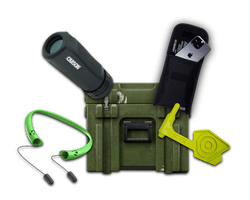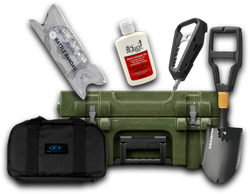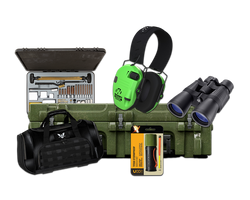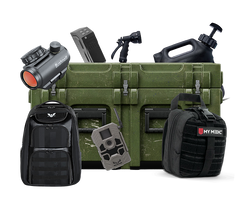
Bolt-Action vs. Semi-Auto Rifle for Precision Shooting
Firearm owners looking for precision shooting rifles often have to choose between a bolt-action and a semi-autos. Generally, shooters prefer the former for accuracy. However, many factors come into play, and which could tilt the scale towards the semi-automatic weapon.
If you are facing the same conundrum, you have come to the right place. Today, we discuss the differences between these rifles. Also, we describe their performance regarding recoil, gas release, and moving components. This way, you will be able to make an easy decision before ordering your next rifle.
Bolt-Action vs. Semi-Auto Rifle - Recoil
The main difference here is in the number of recoil stages. The semi-automatic rifle has three. For instance, two are to the rear and one to the front. On the other hand, the bolt-action has only one to the rear.
Generally, shooters prefer rifles with minimal recoil stages. So, the bolt-action rifle becomes a favorite for those who want to have a superior “drive” of the firearm.
Bolt-Action vs. Semi-Auto Rifle - Gas release
When firing a bolt gun, a cartridge is propelled inside the chamber. Then, the burning force and resulting gases send the bullet traveling down the barrel.
On the other hand, in semi-autos, the same energy returns into the chamber to create a cycle of firing bullets.
If you are a precise shooter, and you prefer faster firing, then the semi-auto rifle should be the first choice ahead of the bolt-action. It can provide you a more precision rifle.
Bolt-Action vs. Semi-Auto Rifle - Moving components
The number of moving components in a rifle influences its performance. Some shooters prefer the bolt-action rifle because it only has one such element. Simply put, the bolt is the only moving component, and the shooter has complete control over it.
The semi-automatic rifle generally has a moving element in either the upper or the lower receiver. When firing, the receiver tends to shift position, which may affect the precision of the bullet trajectory. For instance, if the shooter flinches or improper handling of the weapon could cause the rifle to shoot imprecisely.
Bolt-Action vs. Semi-Auto Rifle - Malfunctions
All rifles tend to malfunction at one point or another. However, it is the potential risks and frequency of such malfunctions that may affect the performance of a rifle, and subsequently, its precision.
Malfunctions in the Semi-Automatic Rifle
Here are the most common ways in which a semi-autos may break down:
- A stovepipe may appear when the casing of a bullet gets stuck in the ejection port.
- The failure to extract a cartridge case from the chamber due to short-recoil cycles.
- The failure to eject a cartridge through the ejection port again from short recoil.
- The double feeding of rounds, which causes the rifle to jam completely.
- A malfunction may take place when loading the rifle and block the feed, chamber, or bolt.
- The failure to fire when a cartridge does not leave the barrel despite being in the chamber when you pull the trigger and release the hammer.
These malfunctions may result from a variety of causes. Firstly, you may have loaded the magazines incorrectly. Secondly, the magazines could be damaged, broken, or defective. Lastly, there could be an accumulation of dirt in and around the bolt and bolt carrier.
Malfunctions in the Bolt-Action Rifle
Contrary to the semi-auto rifle, this rifle produces considerably fewer malfunctions. However, it is not a perfect gun, and some of its defects may include:
- The failure of the firing pin occurs when you close the bolt too quickly or you apply too much force to it. This malfunction results in an inability to fire.
- The failure to fire occurs when a cartridge does not leave the barrel despite you pulling the trigger.
- The failure to feed occurs when the shooter bolt overrides the cartridge in one of the magazines.
Similar to the semi-automatic rifle, these malfunctions may have various causes. For instance, the shooter could be handling the rifle improperly. Additionally, the accumulation of dirt or fouling can prevent the rifle from performing at its best.
Bolt-Action vs. Semi-Auto Rifle - Performance
So far, we know which rifle is more prone to malfunctioning. Also, we know which one has the fewest recoil stages, and which one may be more precise. However, it is their performance in various situations that can ultimately decide the winner of this contest.
Urban Scenario
When facing multiple targets, both defensively and offensively, shooters require a fast-firing rifle. For instance, the speed with which the rounds leave the barrel determines the outcome of this scenario.
Most firearm owners can rely on the efficiency of the bolt-action rifles. However, few of them could manage to shoot it as fast and easy as you can shoot a semi-auto firearm. So, a semi-automatic rifle may be a better choice in a multi-target situation.
Hunting Scenario
In this case, the efficiency of a rifle also depends on the number of targets on-site. For example, bolt-action rifles are more accurate and efficient with just a few rounds. So, if there is a limited number of targets, you can rely on it to complete the job.
A bolt-actions can help you take down anything from deer to large game. It works best when you are out hunting only for large prey that you can shoot with a single bullet from a safe distance.
However, in the case of multiple targets, the semi-automatic rifle maintains its superiority. In the modern day, law enforcement has shifted to using semi-auto rifles. It does its job greatly when shooting multiple targets that are largely obscured, such as vermin. Also, it allows you to shoot from different positions and distances at a higher speed than the bolt-actions.
The Bottom Line
In conclusion, both firearms are efficient in different scenarios. Each can be a precision rifle, but if you are looking for the most precise one, you should consider where and how you are going to use it. Also, you should take into consideration the risk of malfunctions and how much control you want to have over it.Share this article








